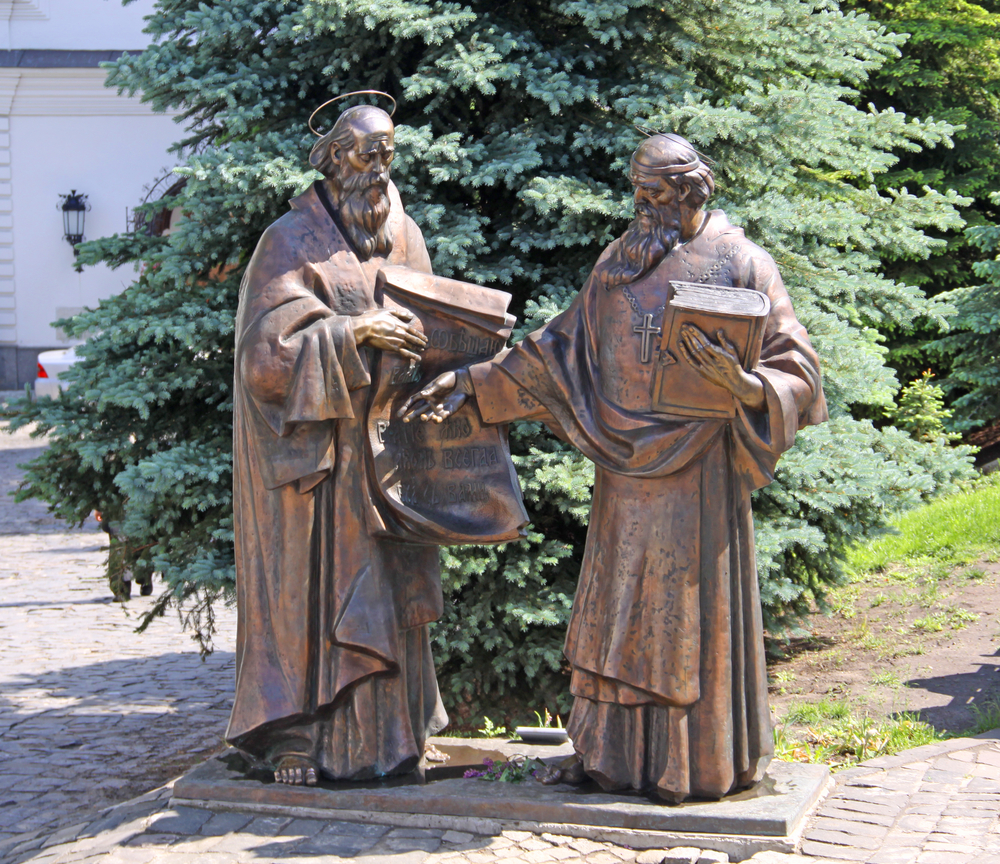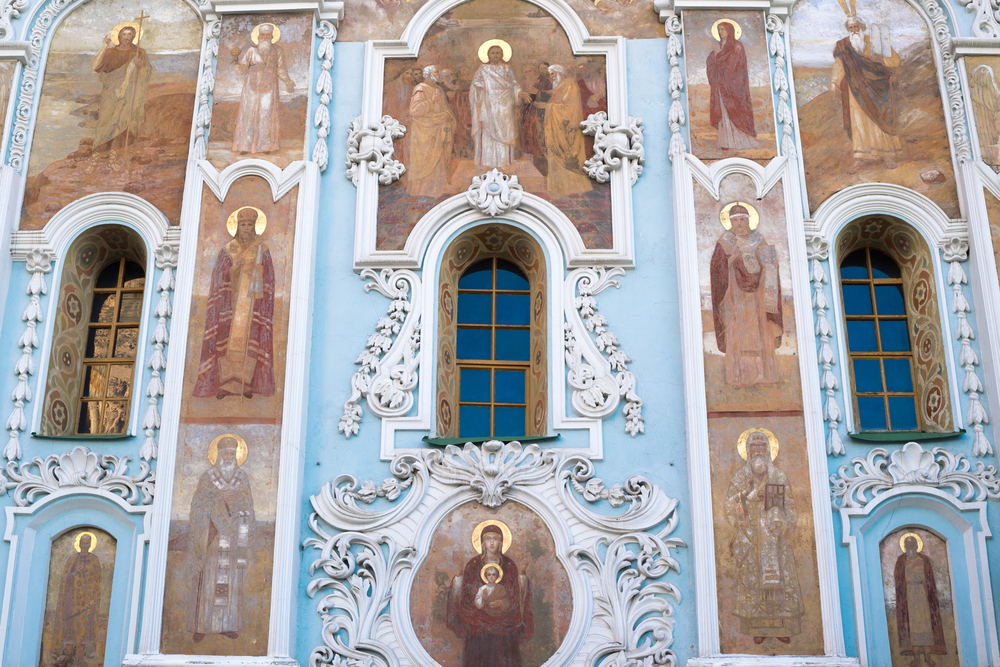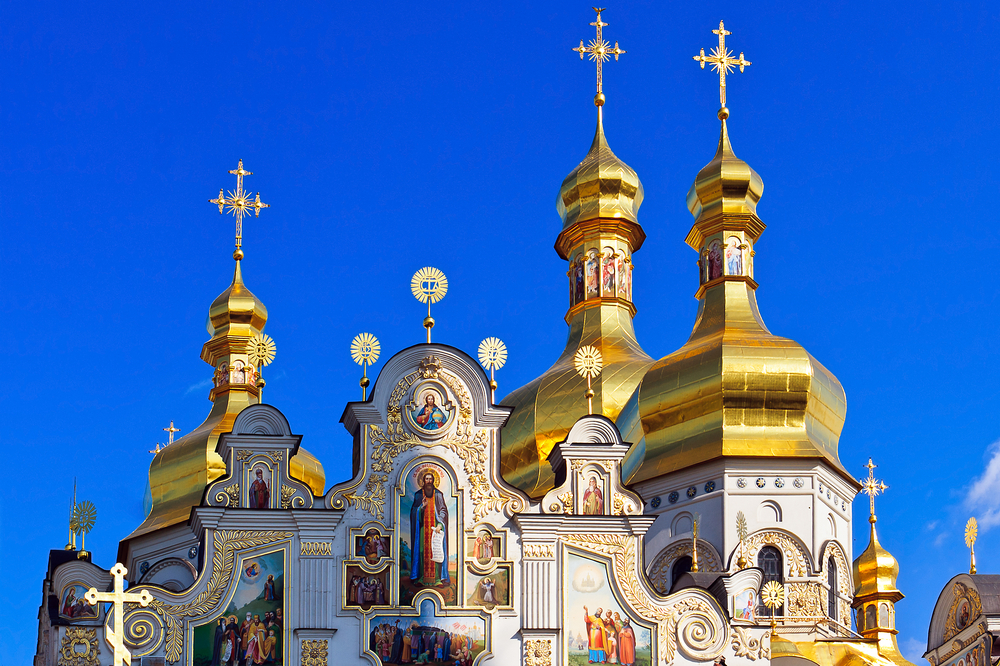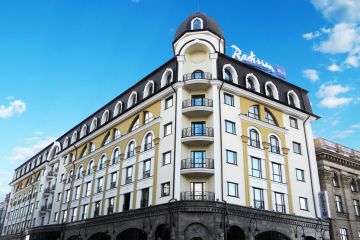Description of Kyiv Pechersk Lavra
 Set on 28 hectares of grassy hills above the Dnipro River, the monastery's cluster of gold-domed churches is a feast for the eyes. The complex is divided into the upper lavra (owned by the government and Kyiv Patriarchate) and the lower lavra (which belongs to the Moscow Patriarchate and contains the caves). Hundreds of explored narrow passages and caves where monks once lived are beneath the lower Lavra. Over 100 bodies remain there mummified in niches carved in stone walls of the caves.
Set on 28 hectares of grassy hills above the Dnipro River, the monastery's cluster of gold-domed churches is a feast for the eyes. The complex is divided into the upper lavra (owned by the government and Kyiv Patriarchate) and the lower lavra (which belongs to the Moscow Patriarchate and contains the caves). Hundreds of explored narrow passages and caves where monks once lived are beneath the lower Lavra. Over 100 bodies remain there mummified in niches carved in stone walls of the caves.
History of Kyiv Pechersk Lavra
 Kyiv Pechersk Lavra has been referred to with many names during its extensive history. It is often referred to as Kyievo-Pecherska Lavra or Lavra Monastery. A lavra is the senior monastery of the region, while pechersk or pecherska means ‚located in caves'. The Greek monk St. Antony founded this monastery in 1051, after Orthodoxy was adopted as Kyivan Rus official religion. He and his follower Feodosy progressively dug out a series of deep caves, where they and other reclusive monks worshipped, studied and lived. When they died their bodies turned into mummies, without any embalming, due to the caves' cool temperature and dryness of the air. The mummies survive even today - confirmation for believers that these were true holy men.
Kyiv Pechersk Lavra has been referred to with many names during its extensive history. It is often referred to as Kyievo-Pecherska Lavra or Lavra Monastery. A lavra is the senior monastery of the region, while pechersk or pecherska means ‚located in caves'. The Greek monk St. Antony founded this monastery in 1051, after Orthodoxy was adopted as Kyivan Rus official religion. He and his follower Feodosy progressively dug out a series of deep caves, where they and other reclusive monks worshipped, studied and lived. When they died their bodies turned into mummies, without any embalming, due to the caves' cool temperature and dryness of the air. The mummies survive even today - confirmation for believers that these were true holy men.
The monastery prospered above ground as well. From the XI century the monastery had been undergoing an intensive construction. The Uspenskiy Cathedral, Troitskaya Church and refectory were built on the territory of the monastery. The monastery played very important role in Ukrainian culture development — the first printing-house was established here, many famous chroniclers, writers, scientists, painters, doctors lived and worked there. In 1113 Chronicler Nestor wrote his «Tale of Bygone Years» («Povest vremennyh let») — the main source of knowledge about the times of Kyiv Rus.
Wrecked by the Tatars in 1240, the Pecherska Lavra went through a series of revivals and disastrous fires before being mostly rebuilt, with its prevailing baroque influences, in the 18th century. It was made a museum in 1926 but was partly returned to the Ukrainian Orthodox Church (Moscow Patriarchate) in 1988.
Interesting facts about Kyiv Pechersk Lavra
 To enter the caves of Kyiv Pechersk Lavra women must wear head scarves and long skirts, men are not allowed in shorts and hats. The Lavra Excursion Bureau sells two-hour guided tours in various languages. As Kyiv’s single most fascinating and extensive tourist site, you will need at least half a day to get a decent introduction.
To enter the caves of Kyiv Pechersk Lavra women must wear head scarves and long skirts, men are not allowed in shorts and hats. The Lavra Excursion Bureau sells two-hour guided tours in various languages. As Kyiv’s single most fascinating and extensive tourist site, you will need at least half a day to get a decent introduction.
To learn more about the history of Kyiv, its religious traditions and eventful past visit Museum of Historical Treasures located at the rear part of Upper Lavra. This museum showcases a rich collection of rare historic items, precious stones, metalwork and jewelry. Its spectacular collection of original Scythian Gold items is the most notable one.
One of the interesting facts about Kyiv Pechersk Lavra is listed in UNESCO heritage site as an ensemble: it includes unique churches with the underground ones, built in the 11th-19th centuries, a complex of labyrinthine caves, as well as domestic and household buildings dated the 17th-19th centuries.
Buildings and structures
 Kyiv-Pechersk Lavra is an architectural ensemble of monastic buildings situated on the plateau overlooking the right bank of the Dnipro River. The ensemble was formed over many centuries in organic combination with the landscape, and acts as a general urban dominant. Founded by St. Anthony and St. Theodosy in the 11th century, the monastery became a prominent spiritual and cultural center that made a significant contribution to the development of education, art and medicine.
Kyiv-Pechersk Lavra is an architectural ensemble of monastic buildings situated on the plateau overlooking the right bank of the Dnipro River. The ensemble was formed over many centuries in organic combination with the landscape, and acts as a general urban dominant. Founded by St. Anthony and St. Theodosy in the 11th century, the monastery became a prominent spiritual and cultural center that made a significant contribution to the development of education, art and medicine.
The architectural ensemble of Kyiv-Pechersk Lavra comprises unique surface and underground churches, built from the 11th to the 19th centuries, with a complex of labyrinthine caves, as well as domestic and household buildings from the 17th to the 19th centuries. The architectural ensemble acquired its modern aspect as a result of construction activities in the 17th to the 18th centuries in the heyday of the Ukrainian Baroque.
Kyiv Pechersk Lavra is one of the most unique architectural structures in the world. It is known far beyond the measures of the country and each year attracts dozens of tourists that wish to visit the Kyiv monastery of caves.
Photo source: shutterstock.com.







